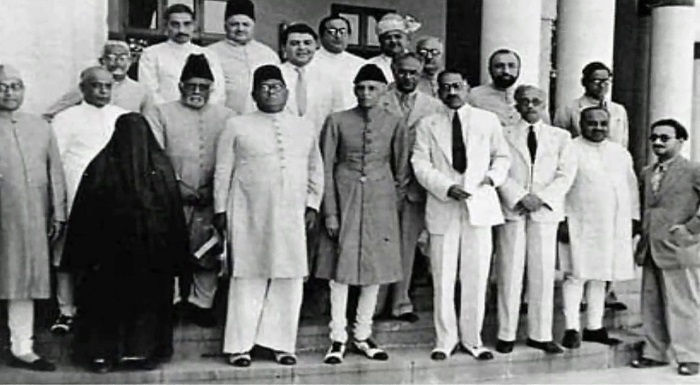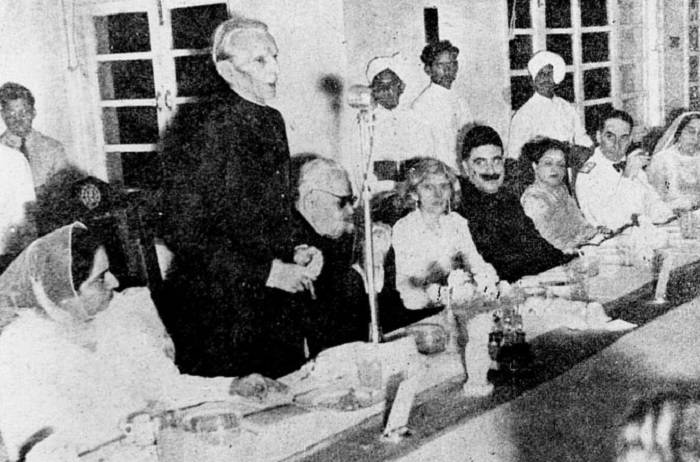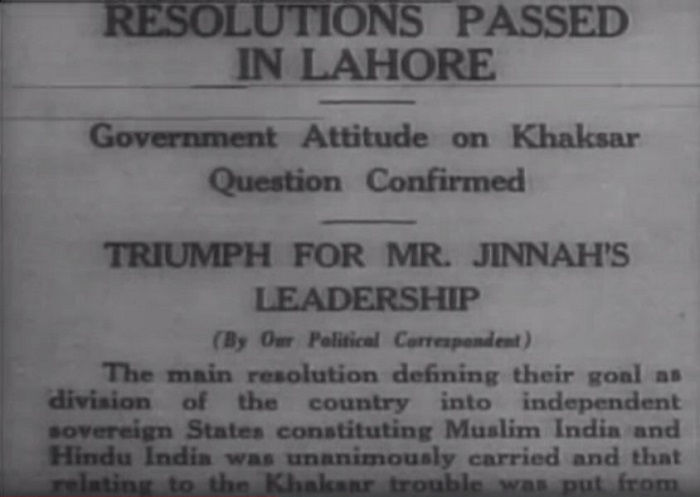Fast Facts
Passed on: 23 March 1940
Passed at: Lahore, Punjab, British India
Written by: Muhammad Zafarullah Khan
Presented by: A. K. Fazl ul Huq
Objective: Creation of a separate state for Muslims
The Lahore Resolution was a formal statement, which sought the creation of a separate Muslim state. The political statement, written by Zafarullah Khan and other prominent members of the ‘All-India Muslim League,’ proposed the creation of an ‘independent state’ based on predominantly Muslim population. When the resolution was put forth by the then Chief Minister of undivided Bengal, A. K. Fazl ul Huq, people started using the word ‘Pakistan’ quite frequently as the Hindu leaders described the resolution as a demand to create Pakistan. Hence, the ‘Lahore Resolution’ is considered as a landmark document in Pakistan’s history. A monument called ‘Minar-e-Pakistan’ stands at Lahore to commemorate the famous resolution. March 23 is observed as a national holiday in Pakistan to celebrate their Republic Day and to commemorate the ‘Lahore Resolution.’
Historical Background
Influenced by the Viceroy’s intention of splitting India into three dominions, one each for Hindus, Rulers of Princely States, and the Muslims, the ‘Muslim League Working Committee’ came up with several sub-committees in order to put forth various proposals regarding the creation of a separate state for the Muslims. The Muslim League did come up with numerous proposals, but the British kept on rejecting them, as they could not succeed in fulfilling their own objectives.
On January 28, 1933, a Punjabi Muslim nationalist Chaudhary Rahmat Ali came up with a pamphlet titled ‘Pakistan Declaration,’ which was presented in the 1933 ‘Round Table conference,’ organized by the British government. The ‘Pakistan Declaration’ stated that the Muslims living in the Northern states of India, namely North-West Frontier Province, Punjab, Sind, Kashmir, and Baluchistan, would want the creation of a separate state. However, the proposal wasn’t taken seriously by the British administration until the ‘All-India Muslim League’ decided to do something about it.

Image Credit : https://www.youtube.com/watch?v=Iqf3zwGpc2w
The Lahore Conference
In 1940, the ‘All-India Muslim League’ held its three-day annual general session from March 22 to 24 at Iqbal Park, Lahore. The welcome speech was delivered by the chairman of the reception committee, Sir Shah Nawaz Khan. The session was then taken over by Muhammad Ali Jinnah, who spoke in favor of creating two independent nations. Jinnah, who was in favor of Gandhi’s policies until recently, had started speaking against co-existing with the Hindus. In his speech on the first day of the three-day session, Muhammad Ali Jinnah explained how Hindus and Muslims cannot co-exist peacefully. He said that the differences between Muslims and the Hindus were so great that forming a central government to govern both the sects under one law could pose serious risks. He further said that Muslims and the Hindus belong to two disparate civilizations, based on conflicting ideas. Jinnah believed that Hindus and the Muslims belong to two different nations as the two groups had different epics and different history to derive inspiration from. He even warned by saying that clubbing Muslims in a country dominated numerically by Hindus would lead to destruction and that it is only fair to create two major dominions, based on religion.
After Liaquat Ali Khan finished presenting his annual report, the then Chief Minister of undivided Bengal, A. K. Fazl ul Huq, moved the resolution in the general session, which came to be known as the ‘Lahore Resolution.’ The resolution, which was primarily written by Sir Muhammad Zafarullah Khan, quickly gathered the support of many prominent Muslims leaders like Mohammad Abdul Ghafoor Hazarvi, Maulana Zafar Ali Khan, Qazi Esa, and Sir Abdullah Haroon. The resolution stated that no constitutional plan will be accepted by the Muslims until geographical units are demarcated, so as to constitute independent states. It also stated that Muslims living in Eastern and North Western zones of British India should be allowed to form an independent state with autonomous and sovereign constituent units. The resolution rejected the proposal of a ‘United India,’ which stood against the division of India, and recommended the creation of a separate state for the Muslims. According to the resolution, the new state should comprise of Muslims from regions like North-West Frontier Province, Punjab, Bengal, Assam, Sindh, and Baluchistan. The resolution, which is sometimes referred to as the ‘Pakistan Resolution’ holds great significance in Pakistan’s history. In 1941, the resolution was made a part of the constitution, framed by ‘All India Muslim League.’

Image Credit : http://www.pmln.us/lahore-resolution-1940/
Interpretation of the Lahore Resolution
The proposed ‘Lahore Resolution’ attracted varied interpretations. Abdul Hashim, one of the members of the ‘Bengal Muslim League,’ interpreted the resolution as a demand for two distinctive countries. After several other interpretations, it was widely believed that the resolution was a call for a separate Muslim nation. However, many argued against this interpretation, claiming that the words ‘independent states’ referred to the liberation of Muslim-dominated provinces, such as Punjab and Sindh, which would be autonomous and sovereign. This interpretation too was accepted by many as popular Muslim political leaders had spoken about creating four Muslim homelands in India in the late 1930s. However, the ‘All-India Muslim League’ leadership later stated that the call was for independence and creation of a separate state for the Muslims. The resolution also became popular as the ‘Pakistan Resolution’ as many considered it to be a proposal to create Pakistan. Though the term ‘Pakistan’ was put forth by Choudhary Rahmat Ali in 1933, the resolution was responsible in making it famous as the word ‘Pakistan’ was now being used throughout India. The term had become so famous that the name Pakistan was eventually used for the envisaged state.
Interestingly, many years after the creation of Pakistan, the ‘Lahore Resolution’ is still open for interpretation as different individuals view it differently. Though many might think that Muhammad Ali Jinnah was clear in stating that he wanted a separate state, which in turn implies that he wanted the partition of India to happen, a Pakistani-American historian and sociologist named Ayesha Jalal claimed in 2012 that Jinnah never actually wanted the partition to happen. She went on to say that the leader of the ‘All-India Muslim League’ had rejected the idea of creating Pakistan twice. She further argued by saying that the resolution had no mention of ‘Pakistan’ and that all Jinnah wanted was control over Punjab and Bengal.

Image Credit : https://en.wikipedia.org/
Lahore Resolution & the Partition of India
During the ‘Second World War,’ the ‘All-India Muslim League’ started gathering support from South Asian Muslims and their ‘two-nation theory’ started getting momentum. However, the then Viceroy of India, Lord Linlithgow, assumed that the ‘All-India Muslim League’ wanted non-federal government sans Hindu domination. Hence in order to assuage the fear of being dominated by the Hindus, Lord Linlithgow announced that future constitution would take into account the views of the minorities as well. But the proposal was rejected by both the ‘Indian National Congress’ and the ‘All-India Muslim League.’
Referring to the Lahore resolution, President of the Constituent Assembly, Dr. Rajendra Prasad stated that neither Hindus nor the Congress wanted partition, but Muhammad Ali Jinnah and the ‘Muslim League’ were clear in their pursuit to create a separate state for the Muslims. Also, the notion of creating a separate state for the Muslims eventually became an integral part of the All-India Muslim League’s political discourse in India.
After the partition of India in 1947, the ‘Lahore Resolution’ was credited for having played an important role in the partition. It was said that the resolution was a decisive step towards finding cultural, economic, social, and political future for the Muslim populace in British India. Though there were many proposals in the past that sought a homeland for Indian Muslims, the ‘Lahore Resolution’ played a key role in the subsequent partition of India.


